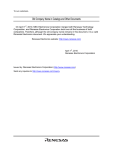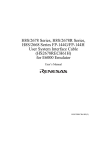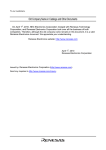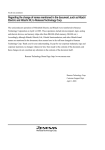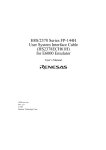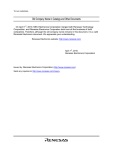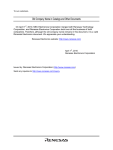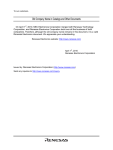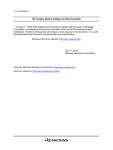Download Renesas FP-144H Product data
Transcript
To all our customers Regarding the change of names mentioned in the document, such as Hitachi Electric and Hitachi XX, to Renesas Technology Corp. The semiconductor operations of Mitsubishi Electric and Hitachi were transferred to Renesas Technology Corporation on April 1st 2003. These operations include microcomputer, logic, analog and discrete devices, and memory chips other than DRAMs (flash memory, SRAMs etc.) Accordingly, although Hitachi, Hitachi, Ltd., Hitachi Semiconductors, and other Hitachi brand names are mentioned in the document, these names have in fact all been changed to Renesas Technology Corp. Thank you for your understanding. Except for our corporate trademark, logo and corporate statement, no changes whatsoever have been made to the contents of the document, and these changes do not constitute any alteration to the contents of the document itself. Renesas Technology Home Page: http://www.renesas.com Renesas Technology Corp. Customer Support Dept. April 1, 2003 Cautions Keep safety first in your circuit designs! 1. Renesas Technology Corporation puts the maximum effort into making semiconductor products better and more reliable, but there is always the possibility that trouble may occur with them. Trouble with semiconductors may lead to personal injury, fire or property damage. Remember to give due consideration to safety when making your circuit designs, with appropriate measures such as (i) placement of substitutive, auxiliary circuits, (ii) use of nonflammable material or (iii) prevention against any malfunction or mishap. Notes regarding these materials 1. These materials are intended as a reference to assist our customers in the selection of the Renesas Technology Corporation product best suited to the customer's application; they do not convey any license under any intellectual property rights, or any other rights, belonging to Renesas Technology Corporation or a third party. 2. Renesas Technology Corporation assumes no responsibility for any damage, or infringement of any third-party's rights, originating in the use of any product data, diagrams, charts, programs, algorithms, or circuit application examples contained in these materials. 3. All information contained in these materials, including product data, diagrams, charts, programs and algorithms represents information on products at the time of publication of these materials, and are subject to change by Renesas Technology Corporation without notice due to product improvements or other reasons. It is therefore recommended that customers contact Renesas Technology Corporation or an authorized Renesas Technology Corporation product distributor for the latest product information before purchasing a product listed herein. The information described here may contain technical inaccuracies or typographical errors. Renesas Technology Corporation assumes no responsibility for any damage, liability, or other loss rising from these inaccuracies or errors. Please also pay attention to information published by Renesas Technology Corporation by various means, including the Renesas Technology Corporation Semiconductor home page (http://www.renesas.com). 4. When using any or all of the information contained in these materials, including product data, diagrams, charts, programs, and algorithms, please be sure to evaluate all information as a total system before making a final decision on the applicability of the information and products. Renesas Technology Corporation assumes no responsibility for any damage, liability or other loss resulting from the information contained herein. 5. Renesas Technology Corporation semiconductors are not designed or manufactured for use in a device or system that is used under circumstances in which human life is potentially at stake. Please contact Renesas Technology Corporation or an authorized Renesas Technology Corporation product distributor when considering the use of a product contained herein for any specific purposes, such as apparatus or systems for transportation, vehicular, medical, aerospace, nuclear, or undersea repeater use. 6. The prior written approval of Renesas Technology Corporation is necessary to reprint or reproduce in whole or in part these materials. 7. If these products or technologies are subject to the Japanese export control restrictions, they must be exported under a license from the Japanese government and cannot be imported into a country other than the approved destination. Any diversion or reexport contrary to the export control laws and regulations of Japan and/or the country of destination is prohibited. 8. Please contact Renesas Technology Corporation for further details on these materials or the products contained therein. Hitachi Microcomputer Development Environment System H8S/2678, H8S/2678R, H8S/2668, H8S/2368, H8S/2378 Series E6000 Emulator HS2678REPI61H Supplementary Information ADE-702-236A Rev. 2.0 04/17/02 Hitachi, Ltd. HS2678REPI61HE Cautions 1. Hitachi neither warrants nor grants licenses of any rights of Hitachi’s or any third party’s patent, copyright, trademark, or other intellectual property rights for information contained in this document. Hitachi bears no responsibility for problems that may arise with third party’s rights, including intellectual property rights, in connection with use of the information contained in this document. 2. Products and product specifications may be subject to change without notice. Confirm that you have received the latest product standards or specifications before final design, purchase or use. 3. Hitachi makes every attempt to ensure that its products are of high quality and reliability. However, contact Hitachi’s sales office before using the product in an application that demands especially high quality and reliability or where its failure or malfunction may directly threaten human life or cause risk of bodily injury, such as aerospace, aeronautics, nuclear power, combustion control, transportation, traffic, safety equipment or medical equipment for life support. 4. Design your application so that the product is used within the ranges guaranteed by Hitachi particularly for maximum rating, operating supply voltage range, heat radiation characteristics, installation conditions and other characteristics. Hitachi bears no responsibility for failure or damage when used beyond the guaranteed ranges. Even within the guaranteed ranges, consider normally foreseeable failure rates or failure modes in semiconductor devices and employ systemic measures such as fail-safes, so that the equipment incorporating Hitachi product does not cause bodily injury, fire or other consequential damage due to operation of the Hitachi product. 5. This product is not designed to be radiation resistant. 6. No one is permitted to reproduce or duplicate, in any form, the whole or part of this document without written approval from Hitachi. 7. Contact Hitachi’s sales office for any questions regarding this document or Hitachi semiconductor products. IMPORTANT INFORMATION READ FIRST • READ this user's manual before using this emulator product. • KEEP the user's manual handy for future reference. Do not attempt to use the emulator product until you fully understand its mechanism. Emulator Product: Throughout this document, the term "emulator product" shall be defined as the following products produced only by Hitachi, Ltd. excluding all subsidiary products. • Emulator station • User system interface cables • PC interface board • Optional SIMM memory module The user system or a host computer is not included in this definition. Purpose of the Emulator Product: This emulator product is a software and hardware development tool for systems employing the Hitachi microcomputer H8S/2678 series, H8S/2678R series, H8S/2668 series, H8S/2368 series, H8S/2378 series (hereafter referred to as the MCU). This emulator product must only be used for the above purpose. Limited Applications: This emulator product is not authorized for use in MEDICAL, atomic energy, aeronautical or space technology applications without consent of the appropriate officer of a Hitachi sales company. Such use includes, but is not limited to, use in life support systems. Buyers of this emulator product must notify the relevant Hitachi sales offices before planning to use the product in such applications. Improvement Policy: Hitachi, Ltd. (including its subsidiaries, hereafter collectively referred to as Hitachi) pursues a policy of continuing improvement in design, performance, and safety of the emulator product. Hitachi reserves the right to change, wholly or partially, the specifications, design, user's manual, and other documentation at any time without notice. Target User of the Emulator Product: This emulator product should only be used by those who have carefully read and thoroughly understood the information and restrictions contained in the user's manual. Do not attempt to use the emulator product until you fully understand its mechanism. It is highly recommended that first-time users be instructed by users that are well versed in the operation of the emulator product. I LIMITED WARRANTY Hitachi warrants its emulator products to be manufactured in accordance with published specifications and free from defects in material and/or workmanship. Hitachi, at its option, will repair or replace any emulator products returned intact to the factory, transportation charges prepaid, which Hitachi, upon inspection, determine to be defective in material and/or workmanship. The foregoing shall constitute the sole remedy for any breach of Hitachi's warranty. See the Hitachi warranty booklet for details on the warranty period. This warranty extends only to you, the original Purchaser. It is not transferable to anyone who subsequently purchases the emulator product from you. Hitachi is not liable for any claim made by a third party or made by you for a third party. DISCLAIMER HITACHI MAKES NO WARRANTIES, EITHER EXPRESS OR IMPLIED, ORAL OR WRITTEN, EXCEPT AS PROVIDED HEREIN, INCLUDING WITHOUT LIMITATION THEREOF, WARRANTIES AS TO MARKETABILITY, MERCHANTABILITY, FITNESS FOR ANY PARTICULAR PURPOSE OR USE, OR AGAINST INFRINGEMENT OF ANY PATENT. IN NO EVENT SHALL HITACHI BE LIABLE FOR ANY DIRECT, INCIDENTAL OR CONSEQUENTIAL DAMAGES OF ANY NATURE, OR LOSSES OR EXPENSES RESULTING FROM ANY DEFECTIVE EMULATOR PRODUCT, THE USE OF ANY EMULATOR PRODUCT, OR ITS DOCUMENTATION, EVEN IF ADVISED OF THE POSSIBILITY OF SUCH DAMAGES. EXCEPT AS EXPRESSLY STATED OTHERWISE IN THIS WARRANTY, THIS EMULATOR PRODUCT IS SOLD "AS IS ", AND YOU MUST ASSUME ALL RISK FOR THE USE AND RESULTS OBTAINED FROM THE EMULATOR PRODUCT. II State Law: Some states do not allow the exclusion or limitation of implied warranties or liability for incidental or consequential damages, so the above limitation or exclusion may not apply to you. This warranty gives you specific legal rights, and you may have other rights which may vary from state to state. The Warranty is Void in the Following Cases: Hitachi shall have no liability or legal responsibility for any problems caused by misuse, abuse, misapplication, neglect, improper handling, installation, repair or modifications of the emulator product without Hitachi's prior written consent or any problems caused by the user system. All Rights Reserved: This user's manual and emulator product are copyrighted and all rights are reserved by Hitachi. No part of this user's manual, all or part, may be reproduced or duplicated in any form, in hardcopy or machine-readable form, by any means available without Hitachi's prior written consent. Other Important Things to Keep in Mind: 1. Circuitry and other examples described herein are meant merely to indicate the characteristics and performance of Hitachi's semiconductor products. Hitachi assumes no responsibility for any intellectual property claims or other problems that may result from applications based on the examples described herein. 2. No license is granted by implication or otherwise under any patents or other rights of any third party or Hitachi. Figures: Some figures in this user's manual may show items different from your actual system. Limited Anticipation of Danger: Hitachi cannot anticipate every possible circumstance that might involve a potential hazard. The warnings in this user's manual and on the emulator product are therefore not all inclusive. Therefore, you must use the emulator product safely at your own risk. III SAFETY PAGE READ FIRST • READ this user's manual before using this emulator product. • KEEP the user's manual handy for future reference. Do not attempt to use the emulator product until you fully understand its mechanism. DEFINITION OF SIGNAL WORDS This is the safety alert symbol. It is used to alert you to potential personal injury hazards. Obey all safety messages that follow this symbol to avoid possible injury or death. DANGER WARNING CAUTION CAUTION DANGER indicates an imminently hazardous situation which, if not avoided, will result in death or serious injury. WARNING indicates a potentially hazardous situation which, if not avoided, could result in death or serious injury. CAUTION indicates a potentially hazardous situation which, if not avoided, may result in minor or moderate injury. CAUTION used without the safety alert symbol indicates a potentially hazardous situation which, if not avoided, may result in property damage. NOTE emphasizes essential information. IV WARNING Observe the precautions listed below. Failure to do so will result in a FIRE HAZARD and will damage the user system and the emulator product or will result in PERSONAL INJURY. The USER PROGRAM will be LOST. 1. Do not repair or remodel the emulator product by yourself for electric shock prevention and quality assurance. 2. Always switch OFF the E6000 emulator and user system before connecting or disconnecting any CABLES or PARTS. 3. Always before connecting any CABLES, make sure that pin 1 on both sides are correctly aligned. 4. Supply power according to the power specifications and do not apply an incorrect power voltage. Use only the provided power cable. V CAUTION This equipment has been tested and found to comply with the limits for a Class A digital device, pursuant to part 15 of the FCC Rules. These limits are designed to provide reasonable protection against harmful interference when the equipment is operated in a commercial environment. This equipment generates, uses, and can radiate radio frequency energy and, if not installed and used in accordance with the instruction manual, may cause harmful interference to radio communications. Operation of this equipment in a residential area is likely to cause harmful interference in which case the user will be required to correct the interference at his own expense. VI Preface Thank you for purchasing the H8S/2678 series, H8S/2678R series, H8S/2668 series, H8S/2368 series, H8S/2378 series E6000 emulator. The H8S/2678 series, H8S/2678R series, H8S/2668 series, H8S/2368 series, H8S/2378 series E6000 emulator (hereafter referred to as the E6000) was designed as a software and hardware development tool for systems based on Hitachi's original microcomputers HD64F2676, HD6432675, and HD6412670. The E6000 provides a CD-R that contains the Hitachi Debugging Interface (HDI) system program, test program, and the user’s manual. There are three manuals for the E6000: the H8S series E6000 Emulator User's Manual, this Supplementary Information, and the Hitachi Debugging Interface User's Manual. The E6000 Emulator User's Manual describes E6000 functions common to all H8S series microcomputers. This Supplementary Information describes the functions specialized for each microcomputer supported by the H8S/2678 series, H8S/2678R series, H8S/2668 series, H8S/2368 series, H8S/2378 series E6000 emulator. Please read this manual before using the E6000. To connect the E6000 to the user system, a user system interface cable for each package type is available. For details on the user system interface cable, refer to the User System Interface Cable User's Manual. The following shows the related manuals: • H8S Series E6000 Emulator User's Manual (HS2000EPI61HE) • Hitachi Debugging Interface User's Manual (HS6400DIIW5SE) • User System Interface Cable User's Manual (HS2678RECH61HE, etc) • The PC interface board user's manual which will be the following manuals: ISA Bus Interface Board User's Manual (HS6000EII01HE) PCI Bus Interface Board User's Manual (HS6000EIC01HE or HS6000EIC02HE) PCMCIA Interface Card User's Manual (HS6000EIP01HE) LAN Adapter User's Manual (HS6000ELN01HE) • Option Memory Board User's Manual 1M SIMM Memory Board User's Manual (HS6000EMS11HE) 4M SIMM Memory Board User's Manual (HS6000EMS12HE) ® ® ® Note: Microsoft , Windows , and WindowsNT are registered trademarks of Microsoft Corporation in the United States and/or in other countries. i Contents Section 1 Overview ........................................................................................... 1 1.1 1.2 1.3 Environment Conditions ...................................................................................................1 Supported MCUs and User System Interface Cables........................................................2 Operating Voltage and Frequency Specifications .............................................................3 Section 2 User System Interface ....................................................................... 5 2.1 2.2 Signal Protection ...............................................................................................................5 User System Interface Circuits..........................................................................................5 Section 3 Notes on Use ..................................................................................... 9 3.1 3.2 3.3 3.4 3.5 3.6 3.7 3.8 I/O Register Differences between Actual MCU and E6000..............................................9 Access to the Reserved Area .............................................................................................9 Use of an Internal RAM Area as External Memory..........................................................10 Support of Flash Memory .................................................................................................10 Hardware Standby .............................................................................................................10 EXDMA controller............................................................................................................10 SIMM Memory Module Access........................................................................................10 Power Supply Follower Circuit.........................................................................................10 Section 4 HDI Parameters ................................................................................. 11 4.1 4.2 4.3 Address Areas ...................................................................................................................11 Access Status.....................................................................................................................12 IRQ Signal Trace...............................................................................................................12 Section 5 Diagnostic Test Procedure ................................................................ 13 5.1 5.2 ii System Set-Up for Test Program Execution .....................................................................13 Diagnostic Test Procedure Using the Test Program..........................................................14 Figures Figure 2.1 Figure 2.2 Figure 2.3 Figure 2.4 Default User System Interface Circuit...................................................................... 6 User System Interface Circuit for MD2, MD1, MD0, NMI, and WAIT.................. 6 User System Interface Circuit for RESET................................................................ 6 User System Interface Circuit for P40 to P47, P54 to P57, Vcc, AVcc, AVss, and Vref Signals ....................................................................................................... 7 Tables Table 1.1 Table 1.2 Table 1.3 Table 1.4 Table 4.1 Table 4.2 Environment Conditions ........................................................................................ 1 H8S/2678 Series, H8S/2678R Series, H8S/2668 Series, H8S/2368 series, H8S/2378 series MCUs and User System Interface Cable..................................... 2 Operating Voltage and Frequency Specifications .................................................. 3 Clock Selections..................................................................................................... 4 Address Area Parameters ....................................................................................... 11 Access Status Parameters ....................................................................................... 12 iii Section 1 Overview The H8S/2678 series, H8S/2678R series, H8S/2668 series, H8S/2368 series, H8S/2378 series E6000 emulator (hereafter referred to as the E6000) is an efficient software and hardware development support tool for application systems using Hitachi's original microcomputers H8S/2678 series, H8S/2678R series, H8S/2668 series, H8S/2368 series, H8S/2378 series. 1.1 Environment Conditions Table 1.1 Environment Conditions Item Specifications Temperature Operating: +10 to +35°C Storage: –10 to +50°C Humidity Operating: 35 to 80% RH; no condensation Storage: 35 to 80% RH; no condensation Ambient gases No corrosive gases AC Power supply voltage 100 V to 240 V AC 50/60 Hz 0.6 A max. AC input cable* HS2678REPI61H 100 V – 120 V (UL) User system voltage (UVcc) Depends on the target MCU within the range 3.0 V to 3.6 V HS2678REPI61HB 200 V – 240 V (BS) Note: HS2678REPI61H must be used at AC100 V-120 V input voltage. HS2678REPI61HB must be used at AC200 V-240 V input voltage. 1 1.2 Supported MCUs and User System Interface Cables Tables 1.2 shows the correspondence between the MCUs and the user system interface cables supported by the E6000. Table 1.2 H8S/2678 Series, H8S/2678R Series, H8S/2668 Series, H8S/2368 series, H8S/2378 series MCUs and User System Interface Cable No. MCU Type Number Package 1 H8S/2678 series 144-pin QFP (FP-144G) HS2678RECH61H 2 H8S/2678R series 144-pin QFP (FP-144H) E6000 User System Interface Cables H8S/2668 series 3 H8S/2368 series 128-pin QFP HS2368ECH61H (FP-128B) 120-pin TQFP HS2368ECN61H (TFP-120) 4 H8S/2378 series 144-pin QFP (FP-144H) 2 HS2378ECH61H 1.3 Operating Voltage and Frequency Specifications Table 1.3 shows the MCU operating voltage and frequency specifications supported by the E6000. If the E6000 is used in an environment that exceeds the operating voltage range and operating frequency range guaranteed for the MCU operation, normal emulator operation is not guaranteed. Table 1.3 Operating Voltage and Frequency Specifications MCU Types Operating Voltage (V) Operating Frequency (φ) (MHz) H8S/2678 Series 3.0-3.6 2-33 H8S/2678R Series, H8S/2668 Series, H8S/2368 Series, H8S/2378 Series 3.0-3.6 8-33 NOTE For details on the operating voltage and frequency specifications, refer to the MCU hardware manual. 3 In the E6000, the clock can be selected by using the Configuration window or the Clock command. Table 1.4 Clock Selections Clock Command Parameter Configuration Window Setting 12 25 33 t t2 12.5 MHz internal clock 25 MHz internal clock 33 MHz internal clock Target Target/2 Notes Default Not supported by the actual MCU. Use this clock only when the required clock duty cannot be obtained. NOTE The system clock (φ) frequency is the same clock frequency input to the XTAL and EXTAL when external clock t is specified in the HDI CLOCK command. For example, when a 20-MHz crystal oscillator is connected to the XTAL and EXTAL of the user system, the system clock (φ) frequency is 20 MHz. When external clock t2 is specified in the HDI CLOCK command, the system clock (φ) frequency is 1/2 of the clock frequency input to the XTAL and EXTAL. The frequency of the E6000 internal clock specified with the HDI CLOCK command is applied to the system clock (φ). 4 Section 2 User System Interface All user system interface signals are directly connected to the MCU in the E6000 with no buffering except for those listed below which are connected to the MCU through control circuits: • • • • • • NMI RESET MD2, MD1, MD0 XTAL EXTAL WAIT 2.1 Signal Protection All user system interface signals are protected from over- or under-voltage by use of diode arrays except for the AVcc and Vref. The Vcc pins (except for the AVcc pin) at the head of the user system interface cable are connected together. The E6000 monitors the voltage level of the Vcc pins and displays the power-supply status in the Status Window. 2.2 User System Interface Circuits The interface circuit between the MCU in the E6000 and the user system has a signal delay of about 8 ns due to the user system interface cable. Thus high-impedance signals will be pulled up to the high level by pull-up resistors. When connecting the E6000 to a user system, adjust the user system hardware to compensate for propagation delays. The following diagrams show the interface signal circuits. 5 Default: Figure 2.1 Default User System Interface Circuit Mode Pins (MD2, MD1 and MD0), NMI, and WAIT: The NMI signal is input to the MCU through the emulator control circuit. The rising/falling time of the NMI signal must be 8 ns/V or less. The mode pins are only monitored. The CPU mode depends on the HDI Configuration settings. Figure 2.2 User System Interface Circuit for MD2, MD1, MD0, NMI, and WAIT RESET: Figure 2.3 User System Interface Circuit for RESET 6 P40 to P47 (pins used for AN0 to AN7 and DA0 to DA1), P54 to P57 (pins used for AN12 to AN15 and DA2 to DA3) Vcc, AVcc, AVss, and Vref: Pins P50 to P57 are also used for interrupt inputs. When the user system is not connected and pull-up resistors are removed, input will be undefined and may illegally detect an interrupt. When P50 to P57 are used to input interrupt signals, it is recommended to connect the pull-up resistors to these pins. Figure 2.4 User System Interface Circuit for P40 to P47, P54 to P57, Vcc, AVcc, AVss, and Vref Signals 7 8 Section 3 Notes on Use 3.1 I/O Register Differences between Actual MCU and E6000 In the E6000, one evaluation chip emulates several types of MCU. Therefore, there are some differences in I/O registers between an actual MCU and the E6000. Note these differences when accessing the I/O registers. I/O port is in the input state at default. The I/O register contents indicate the emulator port status. When the user system interface cable is not connected, the read value is 1 due to the E6000 pullup resistors. In the E6000, accesses to the following registers for controlling the flash memory are invalid. • RAM emulation register (RAMER: H'FEDB) • System control register 2 (SYSCR2: H'FF42) • Flash memory control register 1 (FLMCR1: H'FFC8) • Flash memory control register 2 (FLMCR2: H'FFC9) • Erase block register 1 (EBR1: H'FFCA) • Erase block register 2 (EBR2: H'FFCB) 3.2 Access to the Reserved Area When accessing the reserved area, note the following: If the reserved area is used, the operation in the actual MCU cannot be guaranteed. If the user program extends to the reserved area during debugging, select the MCU having the largest ROM capacity (for example, debug the program for the H8S/2675R with the H8S/2676R memory mapping). 9 3.3 Use of an Internal RAM Area as External Memory An internal RAM area can be used as an external address when the RAME bit of the SYSCR is cleared to "0". Emulator (option memory) cannot be selected for the internal RAM area. Only user memory can be accessed as an external address. Option memory cannot be accessed as an external address. In this case, Memory Mapping setting is the same as the Internal RAM setting. 3.4 Support of Flash Memory The E6000 does not emulate the flash memory control operation in the MCU. 3.5 Hardware Standby When the User Standby enable check box is selected in the Configuration window, the STBY signal of the user system is directly input to the E6000, and the MCU operation stops. When disabling the STBY signal, be sure to keep the oscillator stabilization time and the timing specifications of the RES signal. 3.6 EXDMA controller The H8S/2678 series, H8S/2678R series, H8S/2668 series, H8S/2368 series, H8S/2378 series includes an EXDMA controller that performs direct memory access (DMA) transfers between external addresses. The EXDMA controller can only access User (user memory) and cannot access Emulator (option memory). 3.7 SIMM Memory Module Access When SIMM memory module is used for the external area, memory will always be accessed via 16-bit bus in 3 cycles regardless of the setting of the bus controller. 3.8 Power Supply Follower Circuit If the Configuration dialog box is used to set [User Vcc Threshold], set the Vcc between 2.7 V to 3.6 V. 10 Section 4 HDI Parameters 4.1 Address Areas Table 4.1 lists the parameters for address areas (Area) that can be specified with HDI command line interface or displayed as trace results. Table 4.1 Address Area Parameters HDI Parameter (Trace Display) Address Area Description rom On-chip ROM MCU's on-chip ROM, which can be read but cannot be written to. ram On-chip RAM MCU's on-chip RAM (except for DTC RAM), which can be read and written to. IO16 (I/O-16) Internal I/O registers (16-bit bus) MCU's internal I/O registers for the 16bit bus. IO8 (I/O-8) Internal I/O registers (8-bit bus) MCU's internal I/O registers for the 8-bit bus. ext16 (EXT-16) External area (16-bit bus) External area for the 16-bit bus, which can be allocated to the user system memory or the optional SIMM memory module in the E6000. ext8 (EXT-8) External area (8-bit bus) External area for the 8-bit bus, which can be allocated to the user system memory or the optional SIMM memory module in the E6000.* Dtcram (RAM/DTC) DTC RAM MCU's on-chip RAM for DTC. Note: When SIMM memory module is used for the external area, memory will always be accessed via 16-bit bus. Therefore, the Trace window will always display EXT-16. 11 4.2 Access Status Table 4.2 lists the parameters for access status (Status) that can be specified with HDI command line interface or displayed as trace results. Table 4.2 Access Status Parameters HDI Parameter (Trace Display) Access Status Description dmac On-chip DMAC Access by the MCU's DMAC (Cannot be accessed by the EXDMA controller.) dtc On-chip DTC Access by the MCU's DTC refresh Refresh Refresh cycle by the MCU's refresh controller prefetch (PROG) CPU prefetch Instruction prefetch cycle by the CPU data (DATA) CPU data access Data access for instruction execution by the CPU 4.3 IRQ Signal Trace The H8S/2678 series, H8S/2678R series, H8S/2668 series, H8S/2368 series, H8S/2378 series MCU has 16 interrupt input pins IRQ0 to IRQ15. The E6000 can trace the state of eight interrupt pins simultaneously. To do this, select the IRQ0 to IRQ7 or IRQ8 to IRQ15 checkbox in the configuration window. 12 Section 5 Diagnostic Test Procedure This section describes the diagnostic test procedure using the E6000 test program. 5.1 System Set-Up for Test Program Execution To execute the test program, use the following hardware; do not connect the user system interface cable and user system. • E6000 (HS2678REPI61H) • Host computer • The E6000 PC interface board which will be one of the following boards or card: Select one interface board from the following depending on the PC interface specifications. ISA bus interface board (HS6000EII01H) PCI bus interface board (HS6000EIC01H or HS6000EIC02H) PCMCIA interface card (HS6000EIP01H) LAN adapter (HS6000ELN01H) 1. Install the E6000 PC interface board in the host computer and connect the supplied PC interface cable to the board. 2. Connect the PC interface cable to the E6000. 3. Connect the supplied AC adapter to the E6000. 4. Initiate the host computer to make it enter DOS prompt command input wait state. 5. Turn on the E6000 switch. 13 5.2 Diagnostic Test Procedure Using the Test Program Insert the CD-R (HS2678REPI61SR supplied with the E6000) into the CD-ROM drive of the host computer by pressing the Shift key, move the current directory to <Drive>:\Diag with a command prompt, and enter one of the following commands according to the PC interface board used to initiate the test program: 1. ISA bus interface boad (HS6000EII01H) > TM2678R -ISA (RET) 2. PCI bus interface boad (HS6000EIC01H or HS6000EIC02H) > TM2678R -PCI (RET) 3. PCMCIA interface card (HS6000EIP01H) > TM2678R -PCCD (RET) 4. LAN adapter (HS6000ELN01H) > TM2678R -ELN (RET) The HDI must be installed before the test program is executed. Be sure to initiate the test program from <Drive>:\Diag. Do not initiate it from a directory other than <Drive>:\Diag, such as > <Drive>:\Diag\TM2678R -ISA (RET). If the test program is initiated when the current directory is not <Drive>:\Diag, the test program will not operate correctly. When -S is added to the command line such as > TM2678R -ISA -S (RET), steps 1 to 19 will be repeatedly executed. To stop the execution, enter Q. When -Lfilename is added to the command line such as > TM2678R -ISA -Lfilename (RET), the log name at the execution is saved in filename. When -? is added to the command line such as > TM2678R -ISA -? (RET), online help (option) is displayed. Notes: 1. When the CD-R is inserted into the CD-ROM drive without pressing the Shift key, the HDI installation wizard is automatically started. In such a case, exit the HDI installation wizard. 14 2. <Drive> is a drive name for the CD-ROM drive. 3. Do not remove the CD-R from the CD-ROM drive during test program execution. The following messages are displayed during the test. Message Description E6000 H8S/2678R Emulator Tests Vx.x Test program start message. x.x shows the version number. Copyright (c) 2000 Hitachi Ltd. Option memory board fitted? ( 1. None 2. 1MB 3. 4MB ) : 1 Enter 1 and press the Enter key because the SIMM memory module is not installed in this example. Loading driver .........................OK (Use ISA) Shows that driver software has been correctly loaded. Initializing driver ....................OK Shows that driver software has been correctly initialized. Searching for interface card ...........OK Shows that the PC interface board is correctly installed in the host computer. Checking emulator is connected .........OK Shows that the E6000 is correctly connected to the host computer. Emulator board information: Main board ID: H'5 Emulation board ID: H'18 Shows the ID number of the lower board of the E6000 (always 5) and the upper board of the E6000 (always 18). 15 Companion chip ID: None Option memory board: None Shows the ID number of the companion chip and whether the SIMM memory board is installed. 01) Test Register A) IDR0 Register .............................OK Shows the check results for the registers in the E6000 (normal completion). B) PAGE Register .............................OK C) TRACE G/A Register ........................OK D) PERFM G/A Register ........................OK E) CES G/A Register ..........................OK F) IDR1 Register .............................OK G) IDR2 Register .............................OK 02) Test DPRAM A) Decode Test ...............................OK B) Marching Test .............................OK Shows the results of decoding test and step test for the dualport RAM in the E6000 (normal completion). 03) Test Firmware RAM A) Decode Test page[H'700 - H'71f] ..............OK Shows the results of decoding test for the firmware RAM in the E6000 (normal completion). B) Marching test page[H'700 - H'71f] ..............OK Shows the results of step test for the firmware RAM in the 16 E6000 (normal completion). 04) Test Trace memory A) Decode Test page[H'000 - H'04f](Lower 32K) .....OK Shows the results of decoding test for the trace RAM (first half) in the E6000 (normal completion). B) Marching test page[H'000 - H'04f](Lower 32K) .....OK Shows the results of step test for the trace RAM (first half) in the E6000 (normal completion). C) Decode Test page[H'000 - H'04f](Upper 32K) .....OK Shows the results of decoding test for the trace RAM (last half) in the E6000 (normal completion). D) Marching test page[H'000 - H'04f](Upper 32K) .....OK Shows the results of step test for the trace RAM (last half) in the E6000 (normal completion). 05) Test Map control memory A) Decode Test page[H'200 - H'27f] ........OK B) Marching test page[H'200 - H'27f] ........OK 06) Test Internal ROM and RAM Shows the results of decoding test for the mapping RAM in the E6000 (normal completion). Shows the results of step test for the mapping RAM in the E6000 (normal completion). Shows the results of decoding test and step test for internal 17 A) Decode Test (Internal ROM) ..............OK ROM and RAM in the E6000 (normal completion). B) Marching test (Internal ROM) ..............OK C) Decode Test (Internal RAM) ..............OK D) Marching Test (Internal RAM) ..............OK 07) Test Option RAM No option memory board fitted - test skipped 18 Shows the check results for the optional SIMM memory module in the E6000 (not installed). 08) Test Emulation RAM STEP Operation A) Step Operation ............................OK 09) Test Keybreak A) Key Break .................................OK 10) Test Emulation RAM Hardware Break A) GRD Break .................................OK B) WPT Break .................................OK Shows the check results for the step execution controlling circuits in the E6000 (normal completion). Shows the check results for the forced break controlling circuits in the E6000 (normal completion). Shows the check results for the illegal access break controlling circuits in the E6000 (normal completion). C) WPT(ROM) Break ............................OK 11) Test Internal ROM Write Protect A) Write-Protect .............................OK 12) Test Hardware Break A) Break Point Initialized ...................OK B) Event Detectors CES channel 1-12 ..........OK Shows the check results for the internal ROM write-protection controlling circuits in the E6000 (normal completion). Shows the check results for the hardware break control circuits in the E6000 (normal completion). C) Test Sequencing 1 .........................OK D) Check Range Break .........................OK E) Range Break Test for Data .................OK F) Check Compare Either ......................OK 13) Test Emulation RAM Trace A) Free Trace ................................OK Shows the check results for the trace controlling circuits in the E6000 (normal completion). 19 B) Range Trace ...............................OK C) Point to Point Trace ......................OK D) Start and Stop Event Trace ................OK E) Trace memory Overflow .....................OK F) Time STAMP Trace (33MHz) ..................OK G) Time STAMP Trace (25MHz) ..................OK H) Time STAMP Trace (12.5MHz) ................OK 14) Test Runtime Counter A) Runtime Counter (33.0MHz) .................OK B) Runtime Counter (25.0MHz) .................OK C) Runtime Counter (12.5MHz) .................OK 20 Shows the check results for the run-time counter in the E6000 (normal completion). 15) Test Emulation Monitor A) EMA23-EMA0 ................................OK B) ACST2-ACST0 ...............................OK Shows the check results for the emulation monitor controlling circuits in the E6000 (normal completion). C) ASEST3-ASEST0 .............................OK D) ASEBRKACK .................................OK E) CNN .......................................OK F) NOCLK .....................................OK G) WINDOW ....................................OK 16) Test PERFM G/A A) Time Measurement ..........................OK B) RESERVED Shows the check results for the performance analysis controlling circuits in the E6000 (nomal completion). C) Subroutine Count Measurement ..............OK D) Timeout Function (TIMOT Bit) ..............OK E) Timeout Function (TIMOP Bit) ..............OK 17) Test Bus Monitor A) Register ..................................OK B) Parallel RAM ..............................OK Shows the check results for the bus monitor controlling circuits in the E6000 (normal completion). C) SPRSEL2 ...................................OK D) RAM Monitor ...............................OK 21 18) Test Parallel Access A) Internal ROM Parallel Read Access(WORD) .........OK B) Internal ROM Parallel Write Access(WORD) ........OK C) Internal ROM Parallel Write Access(High Byte) ...OK D) Internal ROM Parallel Write Access(Low Byte) ....OK E) Internal RAM Parallel Read Access(WORD) .........OK F) Internal RAM Parallel Write Access(WORD) ........OK G) Internal RAM Parallel Write Access(High Byte) ...OK H) Internal RAM Parallel Write Access(Low Byte) ....OK I) Option RAM Parallel Read Access(WORD) ...........SKIP J) Option RAM Parallel Write Access(WORD) ..........SKIP K) Option RAM Parallel Write Access(High Byte) .....SKIP L) Option RAM Parallel Write Access(Low Byte) ......SKIP Shows the check results for the parallel access controlling circuits in the E6000 (normal completion). 19) Test RTC A) RTC .......................................OK Shows the check results for the RTC controlling circuits in the E6000 (normal completion). Tests run for xH:xM:xS Shows the check time. Tests passed, emulator functioning correctly Shows that the E6000 is correctly operating. When –S is added to the command line, step 1 will be executed again after step 19. 22






































